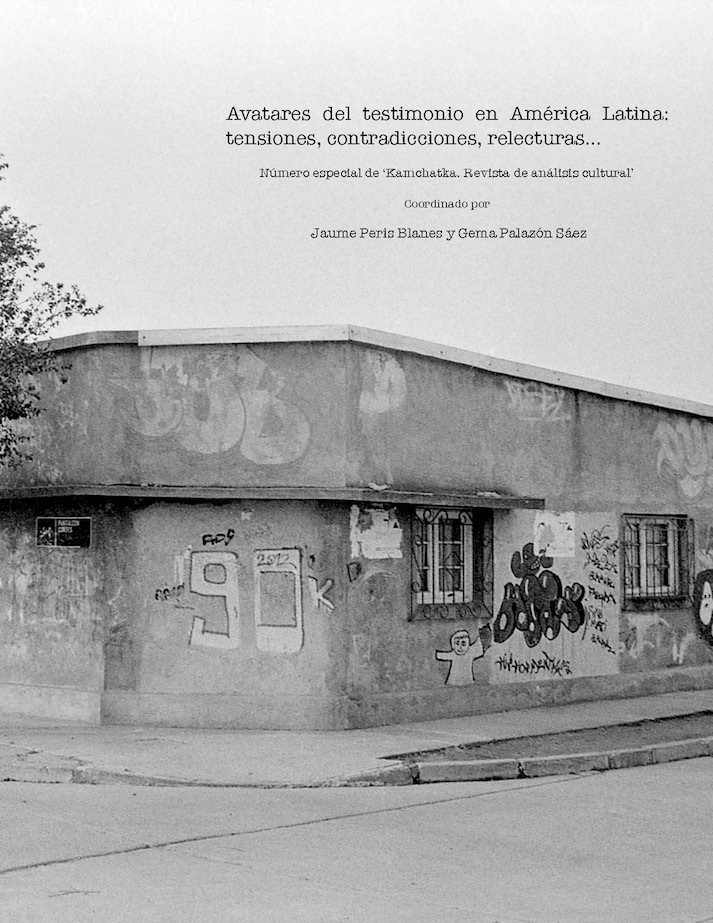'Impuesto a la carne'. El cuerpo-testigo y el contagio de lo común
DOI:
https://doi.org/10.7203/KAM.6.7249Keywords:
Eltit, Chile, postdictadura, dictadura, literatura Abstract
Abstract
Resumen: Ya desde el mismo polifacético título, que alude a una obligación y a una deuda, con la novela Impuesto a la carne (2010), Diamela Eltit indaga la historia chilena (y latinoamericana) a través de la figuración de un poderoso hospital que ‘contiene’ una serie de cuadros históricos.El presente trabajo se propone los siguientes objetivos: 1) analizar la pareja protagónica y su función meta-testimonial; 2) indagar la peculiar relación de las dos mujeres con el espacio que las alberga; 3) examinar las peculiares formas de resistencia de las dos mujeres y su anhelo de evasión. Gracias a la expropiación y donación -concepto de munus-, a la pérdida y ruptura del sujeto, la madre-hija consigue ‘liberarse’ del espacio hospitalario. En las páginas de la novela las protagonistas se exponen al otro, acto que disuelve y difumina toda pretensión de identidad, abriendo los cuerpos (políticos) a las heridas de la alteridad.
Palabras clave: Narrativa chilena, Diamela Eltit, Testimonio, Memoria e identidad.
Abstract: With the novel Impuesto a la carne, published in 2010, the chilean writer Diamela Eltit analyses the history of Chile (y Latin America) through the powerful image of an hospital that shapes a series of allegorical sketches. The purpose of this study is to analyse the construction of the protagonists and their meta-testimonial function; examine the relationship between the two women and the clinical space; investigate their forms of resistance and mechanisms of evasion. The concepts of expropriation and gift (from the latin munus) and the loss of the subject integrity enable the liberation of the women’s bodies and lift them out of their condition. The symbolism of the community represents a new possibility for the Chilean Nation, through the rediscovery of alterity.
Key words: Contemporaneous Chilean Narrative; Diamela Eltit; Literature and Testimony; History, Identity and Memory.
 Downloads
Downloads
 References
References
Bibliografía Agamben, Giorgio (2000). Lo que queda de Auschwitz. El archivo y el testigo. Barcelona: Pre-textos. Assman, Jan (1997), La memoria culturale. Scrittura, ricordo e identità politica nelle grandi civiltà antiche. Torino: Einaudi. Avelar, Idelber (1999). The Untimely Present. Postdictatorial Latin American Fiction and the Task of Mourning. Durham: Duke U.P. Barthes, Roland (1997). El grado cero de la escritura. México: Siglo XXI Barthes, Roland (1999). Mitologías. México: Siglo XXI Capote Cruz, Zaida. “Cuerpos bicentenarios (saqueados pero resistentes)”. La ventana. Revista de estudios de género 4/ 33 (2011): 321-333. Carreño Bolívar, Rubí. Ed. (2009). Diamela Eltit: redes locales, redes globales, Madrid: Iberoa-mericana. Corbin, Megan. (2013). “Archiveras anarquistas: Corporal Testimony in the Work of Diamela Eltit”, Catedral Tomada. Revista de crítica literaria latinoamericana. 1/1 (2013): 1-17. Coromines, Joan & Pascual, José A. (1991-1997). Diccionario crítico etimológico castellano e hispánico. Obra completa. Madrid: Editorial Gredos. Lértora, Juan Carlos, ed. (1993). Una poética de literatura menor: la narrativa de Diamela Eltit. Santiago: Editorial Cuarto Propio. Eltit, Diamela (2000). Emergencias. Escritos sobre literatura, arte y política, Santiago: Planeta, Eltit, Diamela (2000). Impuesto a la carne. Santiago: Seix Barral. Esposito, Roberto (2004). Bíos. Biopolitica e filosofia, Torino, Einaudi. Esposito, Roberto (2003). Communitas. Origen y destino de la comunidad. Buenos Aires: Amo-rrortu. Foucault, Michel. (1988). Vigilar y castigar. Madrid: Siglo XXI. Green, Mary (2007). Diamela Eltit. Reading the Mother. London: Tamesis. Izquierdo Fernández, Gonzalo (1976). “Octubre de 1905. Un episodio en la historia social chile-na”, Historia 13: 55-96. Montecino, Sonia (1999). Sueño con menguante. Biografía de una machi. Santiago: Sudamerica-na. Morales, Leonidas (1998). Conversaciones con Diamela Eltit. Santiago: Cuarto Propio. Moulián, Tomás (1997). Chile actual. Anatomía de un mito. Santiago: LOM-ARCIS. Muñoz Cortés, Víctor (2013). Sin Dios ni patrones. Historia, diversidad y conflictos del anar-quismo en la región chilena (1880-1990). Valparaíso: Mar y Tierra Ediciones. Pastén, Agustín. (2012). “Radiografía de un pueblo enfermo: la narrativa de Diamela Eltit”. Contra Corriente. 10/1 (2012): 88-123. Perassi, Emilia. “Testis, superstes, testimonium. Colectivizar la memoria: la literatura italiana y la dictadura militar argentina”. Confluencia 29/ 1 (2013): 23-32. Pino, Mirian. “Ficción y crónica anarcobarroca en Impuesto a la carne (2010) de Diamela Eltit”, Amerika 10 (2014). Ricoeur, Paul (2004). La memoria, la historia, el olvido. Buenos Aires: Fondo de Cultura Económica. Ricoeur, Paul (1972). “L'herméneutique du témoignage”. Castelli, Enrico. Le Témoignage, Actes du colloque organisé par le Centre international d'études humanistes et par l'Institut d'étu-des philosophiques de Rome. Paris: Aubier-Montaigne: 35-61. Scarabelli, Laura. “La narrativa de Diamela Eltit y los límites del testimonio latinoamericano”. Confluenze,. Rivista di Studi Iberoamericani 4/ 2 (2012): 297-312. Scarabelli, Laura (2013). “Corpi sotto assedio, all’ombra del Bicentenario”. Diamela Eltit, Im-posta alla carne, trad. di Natalia Cancellieri. Roma: Atmosphere Libri:171-176. Scarabelli, Laura. “Impuesto a la carne di Diamela Eltit: etica, estetica e politica della corporeità”, RiMe. Rivista dell’Istituto di Storia dell’Europa Mediterranea 14 (2015): 185-202. Tierney-Tello, Mary Beth. (1996). Allegories of Transgression and Transformation. Experi-mental Fiction by Women Writing Under Dictatorship. Albany: State University of New York Press.
Downloads
Published
How to Cite
-
Abstract2316
-
Artículo (Español)783
Issue
Section
License
This journal provides an immediate free access to the content on the principle that freely make investigation available to the public, which promotes an increased global knowledge exchange.
Unless otherwise indicated, texts published in this journal are under the license Attribution-NonComercial 4.0 by Creative Commons. These texts may be copied, distributed and publicly communicated whenever the publication’s author and title are quoted and whenever they are not used for commercial purposes. In any case, intellectual property of the articles and its potential economic rights entirely belong to its authors.
The full license can be consulted on https://creativecommons.org/licenses/by-nc/4.0/. We encourage authors to disseminate papers published in Kamchatka. Journal of cultural analysis electronically, in institutional digital repository or in their websites.





